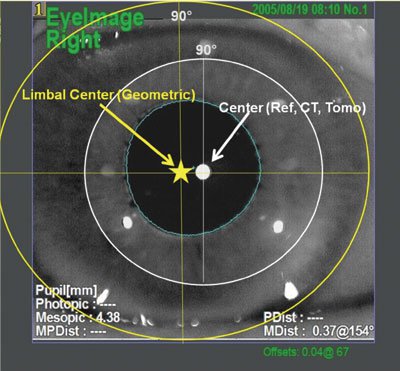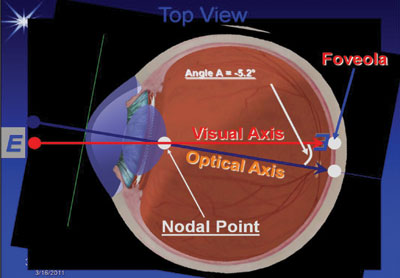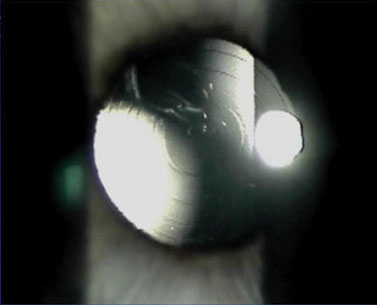Improving toric IOL outcomes, part 2
Reducing a patient’s ocular astigmatism with toric IOLs is on the rise and deservedly so.
 Jack T. Holladay |
Part 1 of this article, in the May 25 issue of Ocular Surgery News, covered measuring corneal astigmatism and toric IOL calculators. In part 2 we will discuss toric optimizer, choosing the residual astigmatic target, proper IOL alignment and centration, and managing unfortunate outcomes of residual astigmatism and higher-order aberrations.
One advanced feature that is included in the Holladay IOL Consultant and will probably soon appear on commercial toric calculators is the toric incision location optimizer. If one enters the pre- and postop keratometry and has operated at many incision angles, then it is possible to determine the average magnitude of the surgically induced astigmatism (SIA) as a function of incision angle (Figure 1). With the patient’s original keratometry readings and knowledge of the magnitude of the SIA by location, it is possible to determine the precise location of the incision to eliminate or minimize the residual astigmatism. The program takes the patient’s original astigmatism and calculates the residual astigmatism for every possible angle of the surgical incision. The result is shown in Figure 2. Notice there are four locations (50°, 130°, 230° and 310°) for which the residual astigmatism is zero. This is usually the case, unless the step size of the toricity of the IOL is not small enough to correct fully the necessary corneal astigmatism, in which case there are two minima (in Figure 1 it would be 90° or 270° and the entire curve would be above zero residual astigmatism). In any case, the computer can always find the best result with the constraints present to give the surgeon the optimal locations for the incision.
 Figure 1. Double angle plot of surgically induced astigmatism. Note the variation in magnitude and variability as a function of the axis. Images: Holladay JT
|
 |
Choosing the optimal residual astigmatism
At the beginning of your experience with a toric IOL, you may be uncomfortable placing the incision at any meridian (some surgeons are only comfortable temporally or superiorly), so it will not be possible to completely eliminate the final residual ocular astigmatism. For example, you may have a choice between a 1.50 D toricity yielding 0.50 D × 90° of residual astigmatism and the 2.25 D toricity yielding 0.12 D × 180°. If the patient had with-the-rule astigmatism initially and you were taught never to flip the axis of astigmatism, many surgeons would choose the first option and leave more residual astigmatism: This is incorrect. Flipping the axis is only of concern in glasses, in which meridional aniseikonia and spatial distortion from spectacles occur due to the base curves, power, astigmatism and vertex distance. Because the goal of a toric IOL is spectacle independence, without glasses the only difference is the size of the blur circle in the conoid of Sturm, so the choice should always be to minimize the residual astigmatism. A patient with 0.50 D of with-the-rule or against-the-rule astigmatism has the same blur on the retina. One should always try to minimize the residual astigmatism to provide the best overall quality of vision. Only if the choice is exactly equal would you choose the IOL with lower toricity. If postoperatively the axis is flipped and the patient needs a spectacle, consider leaving out the cylinder and giving the spheroequivalent prescription. It is paramount that you always choose the toric IOL that achieves the lowest residual astigmatism to attain the best uncorrected vision, regardless of the axis.
Proper IOL alignment, centration
The correct toric alignment is always with the steepest meridian of the postoperative cornea, because the reference marks on the IOL are always on the lowest power meridian. Any deviation from aligning the lowest power meridian of the IOL with the steepest axis of the cornea will result in greater amounts of residual astigmatism. Predicting this axis with the cross-cylinder solution of the SIA and original corneal astigmatism before the cataract incision is very accurate provided the original corneal astigmatism is regular and the magnitude and location of the SIA induced from the incision are precise. Because the SIA is on the order of 0.5 D or less in most small-incision surgery, the change in the axis of astigmatism will be more with lower amounts of original astigmatism than in more astigmatic corneas. Patients with 1.00 D of original corneal astigmatism will have more change in the resulting cross cylinder magnitude and axis from 0.50 D of SIA than 2.00 D of original corneal astigmatism.
Because the toric IOL normally centers in the bag, it will be on the optical axis that is co-linear with the optical axis of the cornea, which in turn is concentric with the limbus (Figure 3). Just like the crystalline lens, the cornea and IOL form an optical axis. The human eye is turned temporally ~5.2° (horizontal angle alpha) and up ~1.3° (vertical angle alpha) to place the image point of fixation on the foveola. The visual axis is the line from the point of fixation through the nodal point (near the posterior pole of the crystalline lens or IOL) to the foveola (Figure 4). The cornea and crystalline lenses are therefore tilted by angle alpha, relative to the visual axis, which induces small amounts of astigmatism and coma. It also results in a decentration of the IOL temporally relative to the cornea. For spherical surfaces (or nearly spherical as with a prolate ellipsoid cornea), this astigmatism and coma are on the order of 0.25 D to 0.50 D and have little effect on the final refraction. For toric surfaces (cornea and IOL), the tilt and decentration result in secondary astigmatism, coma and other higher-order aberrations. For corneal astigmatism greater than 3 D, the induced aberrations are often the limiting factor in the visual quality. As with diffractive multifocal IOLs, the optimal location of the IOL is centered on the 3 mm to 4 mm pupil as shown in Figure 5. Therefore, the IOL should be slightly nasal in the bag to achieve pupillary centration. In most cases, the haptics have to be vertical or slightly oblique to achieve this location. If the haptics are horizontal, self-centering lenses will move back to the center of the bag and appear temporal to the pupil within a few minutes to hours. For toric IOLs, due to this decentration relative to the cornea, it is usually impossible to align the IOL toric marks with the marks on the limbus; at best they can be parallel to this axis as shown in Figure 3.
 Figure 3. Optical axis and visual axis of the eye at the corneal plane. In this right eye, the limbal center is 0.37 mm temporal to the Purkinje-Sanson I image (vertex normal, almost exactly the visual axis). This angle is referred to as angle alpha and is 0.6 mm temporal to the visual axis on the average. Angle kappa is the angle between the pupil center (small blue dot between optical center and vertex normal) and the visual axis, which is usually one-half angle alpha or 2.6° horizontally. |
 Figure 4. Optical and visual axis in horizontal cross section. Angle alpha is the angle between the geometric centers of the cornea and crystalline lens (or IOL) forming the optical axis and visual axis of the eye. The average value is temporally ~5.2° (horizontal angle alpha) and up ~1.3° (vertical angle alpha) to place the image point of fixation on the foveola. |
 Figure 5. A centered multifocal IOL. Note diffraction rings are exactly concentric with the pupil. |
All of these factors result in the toric IOL being placed within ~10° of the optimal axis, but decentration and tilt are rarely considered even by the most meticulous surgeons. New intraoperative instruments such as the ORange from WaveTec have helped reduce any rotational error, but centering the IOL on the pupil is much more difficult because there are no central rings on the optic as with diffractive multifocal IOLs. Intraoperative measurements will become more robust and accurate as the technology improves. These instruments will continue to improve the outcomes of the toric IOL alignment as well as eliminating spheroequivalent refractive surprises.
Managing unfortunate outcomes
When the final refractive outcome has greater than expected residual astigmatism, the first step is to assure that the toric IOL is not tilted or decentered significantly. The second step is to measure the postoperative corneal astigmatism and make sure that the alignment marks on the toric IOL are parallel with the steepest meridian of the cornea. If it is not aligned with the postoperative steep meridian, then the treatment is to rotate the toric IOL to this meridian. Back toric calculators also will be available that will take the postoperative refraction and keratometry to calculate the axis of the toric IOL to confirm that it is the same as the axis measured at the slit lamp. If the axis at the slit lamp and the axis determined by the back calculator do not agree, then something else is wrong, such as decentration, tilt or mislabeled toric IOL.
If the toric IOL is aligned at the steep meridian of the cornea, the residual refractive astigmatic axis will be at or 90° away from the steep meridian of the cornea, depending on whether it was slightly under- or overcorrected by the toric IOL (and whether one uses plus or minus cylinder for the refraction). A wavefront may be obtained, and if the coma, secondary astigmatism and other higher-order aberrations are significant and they are not on the topographic wavefront, then the IOL is decentered or tilted. In most of these cases, if the wavefront is stable and repeatable, a wavefront-guided ablation may be performed to achieve the best vision. Moving the IOL would be unpredictable for correcting the higher-order aberrations.
Toric IOLs are here to stay, are on the rise, and will soon be the dominant form of astigmatism correction with IOL implantation. Following these recommendations should help the surgeon achieve the full potential of these lenses and provide our patients with the best visual outcome.
References:
- Solomon R, Donnenfeld, Perry H, Stein J, Su M, Holladay J. Argon laser iridoplasty to improve visual function following multifocal IOL implantation. Presented at: American Academy of Ophthalmology; November 2007; New Orleans. Presented at: Association for Research in Vision and Ophthalmology; April-May 2008: Fort Lauderdale, Fla.
- Wang L, Koch DD. Effect of decentration of wavefront-corrected intraocular lenses on the higher-order aberrations of the eye. Arch Ophthalmol. 2005;123(9):1226-1230.
- Vinciguerra P. Centering diffractive IOL to pupillary center with 30 G needle at slit lamp. Presented at: Refractive Online 2009; September 2009; Milan, Italy.
- Jack T. Holladay, MD, MSEE, FACS, can be reached at Holladay Consulting Inc., P.O. Box 717, Bellaire, TX 77402; fax: 713-669-9153; email: holladay@docholladay.com; website: www.hicsoap.com.
- Disclosure: Dr. Holladay is a consultant to AcuFocus, Allergan, AMO, Nidek, Oculus, WaveTec and Zeiss.

